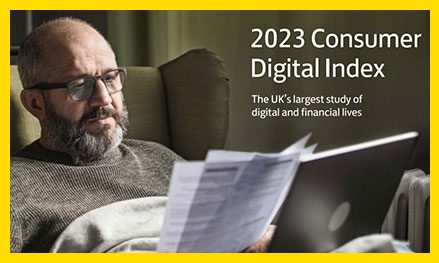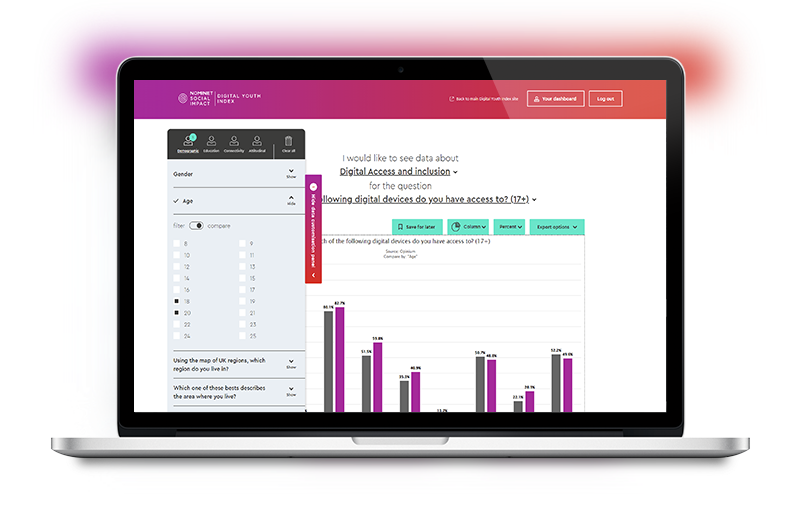The Nominet Digital Youth Index looks at the way that young people are growing up in the digital age, the way that the online world impacts their lives, and the coping mechanisms they have developed.
The most recent data from the 2022 Index found that 53% of young people say online life has a positive impact on their relationships with friends. At Childnet we are passionate about exploring how young people can make the most out of their time online and are empowered to know what to do if something worries, upsets or negatively impacts them when they are online.
As a charity, Childnet have created a range of both free and paid for resources which help young people to build their digital resilience, wellbeing, and other key skills to help them navigate the online world safety, responsibly and respectfully.
Where are the gaps in digital skillsets among young people?
The Digital Youth Index is a key tool in seeing what young people perceive to be the gaps in their digital skillsets, whether this is about knowledge they feel is missing or gaps they see in the online safety education they have received.
The Digital Youth Index found that whilst over 7 in 10 (74.6%) of young people feel digital skills are essential for their future job or career, a fifth (20%) of young people do not feel that they have received good foundational training from school to help them use digital technology. These skills are so important and as a provider of resources to support educators, we see the need for online safety education that is effective, timely and engaging.
The Index also found some gaps in young people’s knowledge, with almost 20% of young people not knowing that what they post online can produce a permanent record that can be accessed by others.
Digital skills don’t just mean knowing how to navigate the online world, as educators supporting young people, it is key that we help young people know what to do if something goes wrong. A third of young people (33.3%) are worried about seeing distressing or upsetting content online, and it is important that this worry does not act as a barrier to them spending and enjoying time on online platforms.
Why is it important to bridge these gaps?
In order for young people to make the most out of their online lives we need to equip them with the right skills for them to flourish online, not only in their childhood but throughout their lives.
When gaps in education or digital skills are identified, it is key that resources and tools are published to support these young people to bridge those gaps. At Childnet we want to make sure that all the resources we create are designed to be practical and help young people.
That’s why we have created a range of both free and paid for resources that help young people to learn about all areas of online safety. There are also resources specifically created for groups of young people who may face specific challenges online, including those in the LGBTQI+ community, woman and girls, and young people with special educational needs. You can see a list of these below:
The Childnet Digital Leaders Programme:
The Childnet Digital Leaders Programme is a youth leadership training programme empowering young people to educate their peers about online safety.
Childnet are the only online safety charity in the UK delivering an online peer-to-peer training programme that directly helps education settings embed a comprehensive approach to online safety.
Groups of Digital Leaders complete training on an interactive, informative and fun platform. They work through online modules, equipping them with the skills they need to go on to educate and support their peers.
Resources for young people with SEND
The STAR Toolkit is a free, online safety teaching toolkit for educators to deliver with young people aged 11-16 with special educational needs and disabilities. The toolkit aims to equip, enable and empower educators with the relevant knowledge they need to support young people with special educational needs and disability (SEND).
Thrive Online is a series of free resources, help sheets and videos helping educators, parents and carers to support young people aged 11 and over with Special Educational Needs and Disabilities (SEND). The free, adaptable resources cover the important topics of healthy relationships, digital wellbeing and online pornography.
Supporting LGBTQ+ young people
Own Your Online Identity is a poster designed to empower individuals in the LGBTQ+ community to embrace themselves online in a way which best suits them. Whilst the poster encourages pupils to express their identities at whichever pace they feel, it also reminds them that there are report and block tools for discriminatory behaviour, as well as the importance of being an upstander in the community.
Resources for under 7s
The Digiduck stories are a collection of five stories created to help parents and teachers educate children aged 3–7 about online safety, with accompanying teaching activities. Follow Digiduck and his pals in these stories of friendship, responsibility and critical thinking online.
On the internet is a learning-to-read book for children aged 4 and above to share with an adult about being ‘on the internet’. On the internet has been written for a child to read, with adult help when needed.
Tackling online sexual harassment
Online sexual harassment is an issue many young people may witness online, our research found that almost a third of girls ages 13-17 years (31%) have received unwanted sexual messages online from their peers in the last year. We have a range of free resources for young people of different ages, as well as for educators and the adults supporting them.
Digital wellbeing and resilience
Digital resilience is a key skill that we want young people to develop. Whilst going online can be incredibly fun and enjoyable there can also be times when a young person can feel upset, not good enough or left out. These are the occasions when young people will need strategies to help themselves and also to help their friends if they are having a difficult time online.
These lesson plans for 11-14 year olds aims to look at the positive and negative experiences young people have online, consider the impact they may have and devise ways to build digital resilience.

Danielle Antha, leads the Childnet Digital Leaders Programme and champions Childnet’s work in equality and diversity, youth empowerment and participation, and impact evaluation.
Share this article








